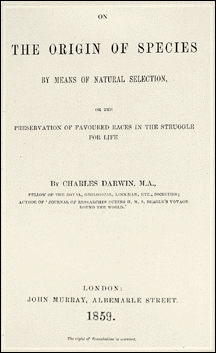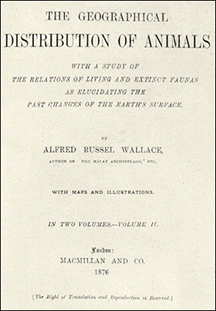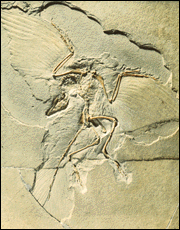
BACK TO THE DINOSAUR AND THE HISTORY OF LIFE HOME PAGE
A major part of this course will be the evolutionary relationships of dinosaurs and how the evolution of key innovations in groups of organisms modifies the Earth system.But what is evolution, how do we know about it, how does evolution function, and how do we know about in the past?
One very important aspect of that order was called the SCALA NATURAE (Scale of Nature) - a concept attributed to Aristotle, ranking things from the inorganic to man and angels.In this view the universe was absolute and full - a concept called the Principle of Plenitude
Concept related to Platonic concept of absolute ideals.
Supported feudal social stratification as well as putting everything in its place - we still have strong vestiges of that concept.
Led to great attempts at classifications.One fundamental problem was - what are the units of life to be classified?
(1706-1778) was a Swedish naturalist who took it upon himself to classify the entire natural world.Linnaeus recognized that interbreeding showed that there was a natural break between organisms that would freely interbreed and those that would not. This was a fact known well by breeders of dogs and other domestic animals.He became known as "God's Registrar"
Linnaeus saw that there was a "unity of type". He showed that the basic unit of natural classification was not the individual but the "species", and that they were recognizable by the fact that the individuals within a species would freely interbreed.In a monumental work on the sexual system in plants Linnaeus showed that the "biological definition of a species" holds true just as well for animals.In other words a species is held together by sex.
Nonetheless, in most cases species are recognized by the fact that members of a species tend to look much more like each other than they do to members of other species.Thus, most species are identified by morphology. Testable by interbreeding.
He noticed that while the fundamental unit was the species, that species could be grouped by similarity of structure into larger groups: genera, families, orders, classes, phyla, and kingdoms (and others in between). We call any entity within this hierarchy a taxon (plural - taxa). Thus a species is a taxon as is a family. This is an inclusive hierarchy.In this "Linnean Hierarchy" are handled specially - a fact you need to know and be familiar with.In other words, kingdoms consist of and contain classes, classes consist of and contain orders, orders consist of and contain families, families consist of and contain genera, genera consist of and contain species.
Here is the Linnean Hierarchy for us:
THE LINNEAN HIERARCHY FOR HUMANS
Phylum Chordata Class Mammalia Order Primates Family Hominidae Genus Homo Species Homo sapiens
In fact, although Linnaeus began by believing that species were fixed entities created by God as is, later in life he began to believe otherwise:that they were "children of time", capable of transformation in form though time — in other words species could evolve.
1) organisms change in their environmentLamarck believed that species could change through time by passing on traits acquired during an individual's life to their offspring - the so-called "acquired characteristics".2) that they discontinuously change and reorganize
But he could not could not deal with concept of extinction.
In this way all variation now and in the past were united by a "Great Chain of Being". It was the Scala Naturae in motion.
His studies made him think all traits of organisms are designed to be a perfectly functional whole.
He believed that there were several different basic plans (bauplans) of organisms - separate creations.With this belief system Cuvier ran right into Lamarck. Cuvier was a successful political animal and managed to have Lamarck ostracized.He also believed that the history of life consisted of separate periods of creation and periods of and extinctions - catastrophes — much like the French Revolution that he survived.
There were other evolutionary concepts around, but like Lamarck's ideas, none took hold because they lacked a clear and observable mechanism
In particular he noted the parallel between species, geography and adaptation and fittedness to environments.To Darwin, this became the central problem - how did organisms within a species become adapted to their roles in the world?
He spelled this out long after his voyages with the Beagle in his Origin of Species (On the Origin of Species by Means of Natural Selection, or the Preservation of Favoured Races in the Struggle for Life, 1859).
Malthus showed that populations if allowed to grow unchecked increase at a geometric rate.Darwin took this concept and combined it with a critical observation.The world could not possibly hold so many, so natural checks are in place. Poverty, disease, war, and famine were all outcomes of increasing population that in fact kept populations of all organisms from increasing. Many more organisms are born than can possibly survive.
Variation of morphology and behavior was a fact of life.The old idea was one of "Ideals" or "Types" of Platonic origin. We still hold to that informally. In the "typological" concept of species, variation is some error around a true ideal form.
But Darwin recognized that variation was at the core of what a species is. There is a statistically average condition, but each variant is as real as any other and there is no ideal condition. This concept of type is unfortunately still very much part of racial thinking and has no place in modern biology.Darwin realized that this natural variation led to differential survival based on that variation. For a given environmental context some variants would fair better than others in the "struggle for existence".Darwin was espousing "populationist thinking".

Darwin was a domestic pigeon breeder (as a part of his research) and knew that humans had long taken advantage of natural variation to select for breeds; this is artificial selection. Hence Darwin called his explanation "Natural Selection".
Darwin noted clearly the fact that the most closely related (similar) species were often found closest together in geography.
There are 5 parts to Darwin's Natural Selection:Remember: Populations and species evolve, individuals do not.
1. Heredity of most features2. Heritable Variation in the population
3. Variation leads to differential rates in survival and reproductive success among the variations.
4. Differential survival and reproduction leads to a shift in the frequency of characters, leading to a shifting of mode within the species.
5. If this process goes on long enough, parent and daughter species can no longer interbreed.
Two wonderful examples, studied by Darwin and still studied today, are the so-called "Darwin's Finches", members of the family Geospizidae in the Galapagos Islands, and the islands' giant tortises.
 Alfred Russell Wallace (1823-1913) came up with vitually the same concept of natural selection more or less independently through his studies on the Malay archipelago. Darwin panicked because he was not ready with his book yet!
Alfred Russell Wallace (1823-1913) came up with vitually the same concept of natural selection more or less independently through his studies on the Malay archipelago. Darwin panicked because he was not ready with his book yet!
Both gave papers at the same time and the same subject at the Linnean Society meeting of 1858 (thanks to Charles Lyell and Joseph Hooker).By the way, the phrase "survival of the fittest" comes originally not from Darwin but rather from Herbert Spencer who adopted Darwin's ideas to a general progessionist philosophy (many say inappropriately), although Darwin adopted the term in his later editions of the Origin of Species on advice from Wallace.
2. STRAINS OF BACTERIA adapting to changes
3. IN PAST - PREDICTIONS OF INTERMEDIATES - BIRDS - ARCHAEOPTERYX

We know about evolution from 5 classes of order in organisms:
ORDER IN CHARACTERS (comparative anatomy)
ORDER IN GENETICS
ORDER IN DEVELOPMENT (embryology)
ORDER IN GEOLOGICAL RECORD
ORDER IN GEOGRAPHIC DISTRIBUTIONS
1. microevolutionEven within this we can recognize two modes:
2. evolution of taxa
3. evolution of key innovations
ANAGENESIS VS. CLADOGENESIS (see also discussion in Transitional Vertebrate Fossils FAQ)Then rates of evolution are a different matter again:
GRADUAL VS. PUNCTUATEDDARWIN'S GAPS
As an aside, it is worth noting that Darwin initially regarded the fossil record as a bit of an embarrassment. In 1859, there were no fossil intermediate forms known between major groups from the fossil record. To argue his point Darwin needed to insist that the fossil record was very incomplete because of gaps in sedimentation. Of course this begs the question of rates of evolution. It now seems that some of the apparent gaps are due to very rapid change indeed.
1. small numbers
2. isolation
3. extreme conditions (intense selection)
SO THIS IS WHERE WE GET WHAT WE SEE IN THE GEOLOGICAL RECORD - CREATION OF DIVERSITYFrom this comes:
€ THE PRINCIPLE OF BIOTIC SUCCESSIONHOW, IN DETAIL, DO WE WORK OUT THE EVOLUTIONARY RELATIONSHIPS OF FOSSIL AND RECENT SPECIES?
http://www.astro.virginia.edu/~eww6n/bios/Plato.html(Eric's Treasuretrove of Science: Plato (ca. 427-ca. 347 BC) - home page at http://www.astro.virginia.edu/~eww6n/)
http://museon.museon.nl/objextra.eng/linnaeus.html (Museon: the popular-science museum in The Hague, Netherlands: Linnaeus - home page at http://museon.museon.nl/eindex.html)
http://userwww.sfsu.edu/~rsauzier/Darwin.html (Glass Bead Game (Das Glasperlenspiel): Darwin, Charles (1809-82)) - home page at: http://userwww.sfsu.edu/~rsauzier/Biography.html#Biology)
http://www.clements.umich.edu/Photogal/bib/Darwin.html (Portraits from the Photographic Collections of the William L. Clements Library: Half length photograph of Charles Darwin) - home page at: http://www.clements.umich.edu/Photogal/people.html)
http://www.literature.org/Works/Charles-Darwin/ (An Online Literature Library: Charles Darwin - http://www.literature.org/)
http://www.ucmp.berkeley.edu/history/malthus.html (Enter Evolution: Thomas Malthus (1766-1834) - http://www.ucmp.berkeley.edu/history/evolution.html)
http://www.hyperhistory.com/online_n2/people_n2/persons2_n2/plato_ideas.html (History of the World: Greece (Plato's theory of ideas) - http://www.hyperhistory.com/)
http://www.cc.columbia.edu/acis/bartleby/bartlett/423.html (PROJECT BARTLEBY ARCHIVE:Charles Darwin. 1809-1882 - http://www.columbia.edu/acis/bartleby/)
http://www.talkorigins.org/faqs/archaeopteryx/info.html (The Talk Origin Archive: All About Archaeopteryx by Cris Nedin http://www.talkorigins.org/)
http://www.mq.edu.au/hpp/Ockham/z3602.html (Macquarie University: PHIL360 - Later Medieval Philosophy; Tape 2: Scotus's proof of the existence of an infinite being).
http://www.ucmp.berkeley.edu/history/evolution.html (Enter Evolution)